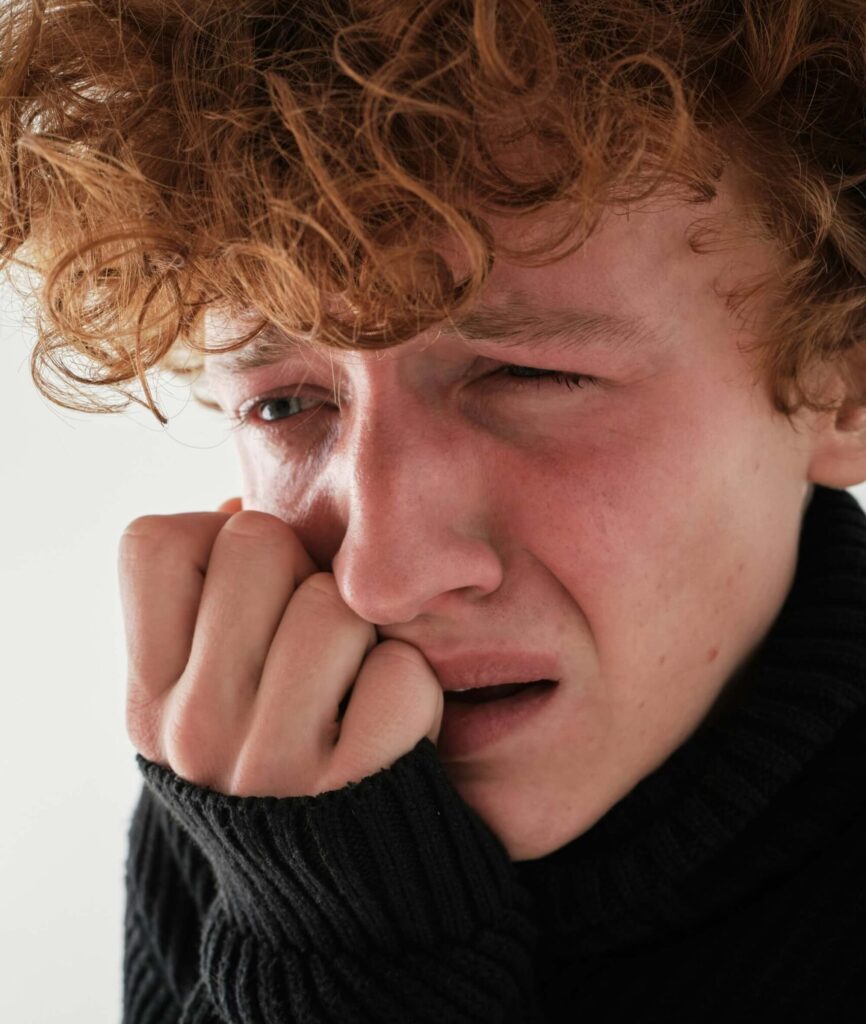Feeling down occasionally is a part of life, but when low mood becomes persistent and overwhelming, it may indicate a more serious condition: depression. Depression is a widespread mood disorder that affects approximately 5.4% of Canadians. It is characterized by enduring feelings of sadness, a lack of interest in activities once enjoyed, and a variety of emotional and physical symptoms that significantly impact daily functioning.
Depression, whether it manifests as major depressive disorder or peripartum depression, is a mental health condition, not a sign of personal weakness. It alters brain chemistry, making it challenging to experience happiness or motivation. Understanding the causes, diagnostic methods, and treatments for depression is crucial. Keep reading to learn more about depression.


Depression is characterized by persistent low mood, anhedonia (i.e., the inability to feel pleasure), anergia (i.e., feelings of low energy), irritability, and various cognitive and physical symptoms. These symptoms are accompanied by complex changes in the brain at multiple levels, including molecular, cellular, structural, and functional alterations.
Unlike normal mood fluctuations, depression lasts most of the day, nearly every day, for at least two weeks, associated with impairment in at least one domain of personal, educational, and social functioning. Understanding how depression manifests in the brain involves examining these multifaceted changes across different levels.
Here in Canada, depression is far from uncommon. In fact, statistics show about 11% of Canadians will experience major depression at some point in their lives, it means that around 1 in 8 Canadians will experience this condition. That translates to thousands of people feeling the weight of this condition.
So, if you’re part of these statistics, or you know someone who might be, remember: you’re not alone, and help is available.

Depression is a complex mental health disorder that manifests in a variety of emotional, cognitive, and physical symptoms. Understanding these symptoms can help identify the condition and guide you towards seeking appropriate treatment. Let’s explore the key symptoms according to the DSM-5-TR:
This is the most common symptom, characterized by feelings of sadness, emptiness, or hopelessness. It may be expressed as feeling “down” most of the day, nearly every day. For children or adolescents, this mood can appear as irritability.
A marked reduction in interest or pleasure in all, or almost all, activities is a key feature of depression. This includes hobbies, social activities, and daily routines that were once enjoyable.
Insomnia (difficulty sleeping) or hypersomnia (excessive sleep) can occur almost every day. Also, the quality and duration of sleep may change dramatically.
Persistent fatigue, even after sufficient rest, is a common symptom. You may often feel physically and mentally drained.
Depression affects cognitive function, making it difficult to concentrate, think clearly, or make decisions. This symptom can affect work and personal relationships.
Individuals with depression often experience inappropriate feelings of guilt or worthlessness. These feelings can be persistent and may not be related to specific events
Physical signs like headaches, muscle aches, digestive problems, and changes in appetite (either overeating or loss of appetite) are frequently associated with depression. These physical symptoms can often be misinterpreted, making diagnosis challenging
Depression can manifest physically through psychomotor agitation (restlessness, inability to sit still) or psychomotor retardation (slowed movements, speech, or reactions).
Depression can lead to noticeable weight loss (when not dieting) or weight gain. This symptom reflects changes in appetite, such as overeating or lack of interest in food.
Thoughts of death, suicide ideation, or actual attempts are serious symptoms.
Notice that to meet the criteria for depression, you must experience five or more symptoms during the same two-week period, and at least one of these must be either depressed mood or loss of interest or pleasure (anhedonia).
It is noteworthy that there is significant differences in the symptoms of depression in women and signs of depression in men. Women typically exhibit more internalizing symptoms such as sadness, anxiety, and emotional dysregulation, while men often display externalizing symptoms like irritability, substance misuse, and risk-taking behaviors.
At Different Clinic, our professional team trained to recognize these signs and help you navigate through them.
Let’s delve into the core issue: What leads to depression? If you’re expecting a straightforward explanation, you might be disappointed. Depression is a multifaceted condition, influenced by a complex combination of factors. Here are some of the latest insights into its causes:
Research indicates that depression can run in families, suggesting a genetic component. Individuals with a family history of depression are at a higher risk, with studies showing that if one identical twin has depression, the other has a 70% chance of developing it as well.
Chemical imbalances in the brain, particularly involving neurotransmitters such as serotonin, dopamine, and norepinephrine, are linked to depression. These chemicals play critical roles in regulating mood and emotional responses. Abnormalities in their levels can lead to depressive symptoms.
Imaging studies have shown that certain brain regions, including the amygdala and hippocampus, may be altered in individuals with depression. For instance, a smaller hippocampus has been observed in some depressed individuals, which may affect memory and emotional regulation.
Hormonal fluctuations, such as those occurring during puberty, pregnancy, postpartum periods, or menopause, can trigger or exacerbate depressive symptoms.
Reduced sunlight during the fall and winter months can lead to a drop in serotonin levels, a neurotransmitter that affects mood. This decrease in serotonin can trigger depression. Additionally, changes in the season can disrupt the balance of melatonin, a hormone that regulates sleep patterns and mood.
Nutritional deficiencies can have a significant impact on depression. Certain key nutrients, such as vitamin D, B vitamins, omega-3 fatty acids, magnesium, zinc, and selenium, play crucial roles in brain function and emotional regulation. A deficiency in these nutrients can lead to impaired neurotransmitter function, increased inflammation, cognitive decline, and a compromised stress response, all of which contribute to the onset and severity of depressive symptoms.
Certain personality characteristics, such as low self-esteem, pessimism, and a tendency to be easily overwhelmed by stress, can increase susceptibility to depression. Individuals with these traits may interpret life events more negatively, leading to feelings of hopelessness.
Cognitive theories suggest that negative thought patterns and maladaptive coping strategies can contribute to the onset of depression. Individuals who frequently engage in self-criticism or catastrophizing may find themselves trapped in a cycle of negative thinking, which can worsen depressive symptoms.
Isolation and loneliness create a cycle that can worsen depression. Loneliness, defined as the distress from perceived social disconnection. It often leads to negative thought patterns and low self-esteem, which can exacerbate depressive symptoms. Biologically, loneliness can alter brain function in areas related to emotion and social cognition, increasing stress responses and inflammation. Additionally, it can promote unhealthy behaviors, such as poor diet and inactivity, further heightening the risk of depression.
Significant life changes or traumatic experiences, such as the loss of a loved one, divorce, job loss, or exposure to violence, can trigger depression. These stressors can overwhelm an individual’s coping mechanisms, leading to a breakdown in emotional health.
Ongoing stress from various sources, including work, relationships, and financial difficulties, can contribute to the development of depression. Chronic stress can lead to changes in brain chemistry and function, making individuals more vulnerable to depressive episodes.
A lack of social support or feelings of isolation can increase the risk of depression. Strong social connections are protective factors, while loneliness can exacerbate feelings of sadness and hopelessness.
Poor lifestyle choices, such as physical inactivity, unhealthy eating habits, and substance use, can also contribute to depression. These factors can create a cycle where depression leads to further unhealthy behaviors, worsening the condition.
While not a direct cause, excessive use of social media and technology can contribute to feelings of loneliness and inadequacy. Constantly checking other people’s life and comparing their life with yours could cause negative feeling.
Scientists found that: First, women are more likely to experience depression than men. Several factors contribute to this gender difference. Biological factors, such as hormonal fluctuations related to menstrual cycles, pregnancy, and menopause, can influence mood and increase vulnerability to depression in women. Additionally, social determinants such as gender roles, expectations, and experiences of trauma or discrimination can exacerbate mental health issues among women. Second, Men may exhibit different symptoms and coping mechanisms, often turning to substance abuse or externalizing behaviors rather than seeking help, which can lead to underdiagnosis of depression in this group.
Depression manifests in different ways for different people. The DSM-5-TR (Diagnostic and Statistical Manual of Mental Disorders, Fifth Edition, Text Revision) classifies several types of depression. What differs among them are issues of duration, timing, or presumed etiology. These categories include:
Depression can often present as a combination of different types, making it challenging to categorize precisely. Therefore, seeking professional assistance is essential for an accurate diagnosis and a personalized treatment plan. At Different Clinic, we specialize in identifying and managing various forms of depression. We are here to help you understand your condition. Let’s discuss the diagnosis of depression.
Diagnosing depression is not as straightforward as checking for a fever with a thermometer. It requires an involving time, careful observation, and expertise.
At Different Clinic, we utilize these methods to assess and provide the appropriate treatment for you. You can read more about our assessment process here.

There is no universal approach to treating depression. Fortunately, Different Clinic offers a variety of effective treatments, including:
Remember, treating depression is a process. It’s not about quick fixes. It’s about consistent effort, patience, and the right support. But with the right plan, you can absolutely beat depression and get back to enjoying life.
We have covered a wealth of information about depression, from understanding its nature and recognizing its symptoms, to exploring the causes and risk factors, discussing diagnosis, and examining treatment options. Depression is common and serious, but it is also treatable.
If you are dealing with depression or suspect you might be, do not try to handle it alone. It is similar to playing a hockey game without any teammates exhausting and unlikely to end well. Reach out for help.
References:
4711 Yonge St., 10th Floor, Unit 10097, Toronto, ON M2N 6K8
Monday to Friday 8:00 AM to 8:00 PM / Weekends: Saturday from 10:00 AM to 6:00 PM.

